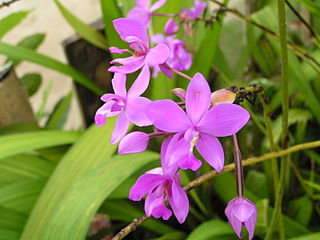
Spathoglottis, commonly known as purple orchids or 苞舌兰属 is a genus of about fifty species of orchids in the family Orchidaceae. They are evergreen terrestrial herbs with crowded pseudobulbs, a small number of leaves and medium-sized resupinate flowers on an upright flowering stem. The sepals and petals are all similar to each other and are white, yellow, pink or purple. Species of Spathoglottis are found from eastern and south-eastern Asia to Australia and some Pacific Islands.

Thrixspermum, commonly known as hairseeds or 白点兰属 , is a genus of flowering plants in the family Orchidaceae. Orchids in this genus are epiphytes, lithophytes or terrestrial plants with flat, leathery leaves and short-lived flowers with the sepals and petals more or less similar to each other. The labellum is rigidly fixed to the column and has three lobes. The side lobes are erect and the middle lobe is thick and fleshy. There are about 190 species distributed from tropical and subtropical Asia to the Western Pacific. Most species grow in lowland or tropical rainforests up to an altitude of 1,200 m.
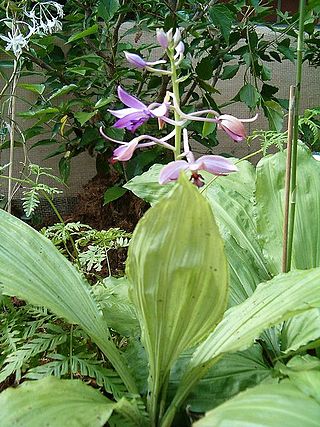
Calanthe, commonly known as Christmas orchids, is a genus of about 220 species of orchids in the family Orchidaceae. They are evergreen or deciduous terrestrial plants with thick roots, small oval pseudobulbs, large corrugated leaves and upright, sometimes arching flowering stems. The sepals and petals are narrow and a similar size to each other and the labellum usually has spreading lobes.

Gastrodia, commonly known as potato orchids, is a genus of terrestrial leafless orchids in the family Orchidaceae, about ninety of which have been described. Orchids in this genus have fleshy, upright stems and small to medium-sized resupinate flowers with narrow sepals and petals. They are native to Asia, Australia, New Zealand, central Africa, and various islands of the Indian and Pacific Oceans.
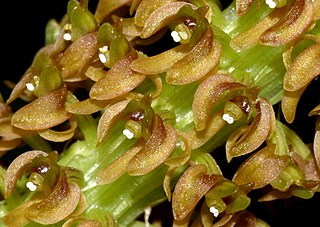
Dienia, commonly called snout orchids, is a genus of six species of orchids in the family Orchidaceae. Plants in this genus are evergreen, mostly terrestrial plants with a fleshy, above ground stem, large, pleated leaves and small, non-resupinate flowers with thin sepals and petals. The labellum is short and tongue-like. The genus is distributed in Southeast Asia, Australia, Micronesia and Melanesia.
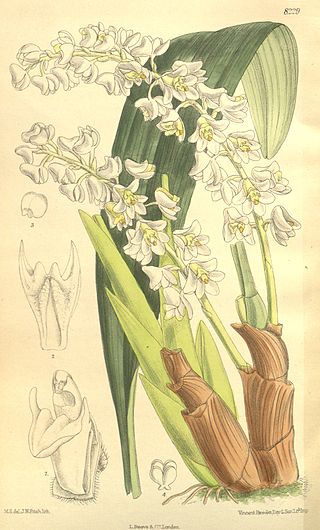
Bryobium, commonly known as urchin orchids or 藓兰属 , is a genus of flowering plants in the family Orchidaceae. Orchids in this genus are epiphytic or lithophytic plants with large, fleshy pseudobulbs, each with up to three leathery leaves and small, often hairy flowers. These orchids are found from tropical Asia to northern Australia.

Cylindrolobus is a genus of orchids with about 80 species that grow in New Guinea, Wallacea, Southeast Asia, southern China, and India.

Pinalia, commonly known as gremlin orchids, is a genus of flowering plants in the family Orchidaceae. Orchids in this genus are large epiphytic or lithophytic plants with prominent pseudobulbs, each with up to three thin, flat leaves and cup-shaped, relatively short-lived flowers with scale-like brown hairs on the outside. There are about 120 species occurring from tropical to subtropical Asia to the south-west Pacific.

Dipodium, commonly known as hyacinth orchids, is a genus of about forty species of orchids native to tropical, subtropical and temperate regions of south-east Asia, New Guinea, the Pacific Islands and Australia. It includes both terrestrial and climbing species, some with leaves and some leafless, but all with large, often colourful flowers on tall flowering stems. It is the only genus of its alliance, Dipodium.

Robiquetia, commonly known as pouched orchids, is a genus of flowering plants from the orchid family, Orchidaceae. Plants in this genus are epiphytes with long, sometimes branched, fibrous stems, leathery leaves in two ranks and large numbers of small, densely crowded flowers on a pendulous flowering stem. There are about eighty species found from tropical and subtropical Asia to the Western Pacific.

Trichoglottis, commonly known as cherub orchids or 毛舌兰属 , is a genus of flowering plants in the family Orchidaceae. Orchids in this genus are epiphytic plants with thick roots, relatively thick, fibrous stems and many large, thick, leathery leaves arranged in two ranks. The flowers are usually small and yellowish with light brown or purple markings. The flowers have broad sepals, narrower petals and a labellum which has three lobes and is often hairy. There are about 85 species distributed from tropical and subtropical Asia to the north-western Pacific. Most species grow in rainforest.
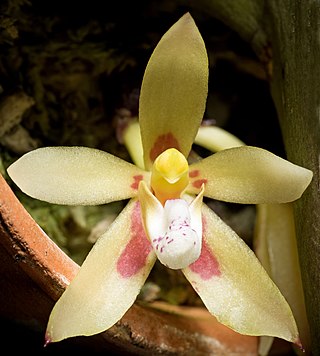
Brachypeza, commonly known as sage orchids, is a genus of flowering plants from the orchid family, Orchidaceae. Orchids in this genus have short stems with fleshy leaves and arching flowering stems with short-lived flowers. The sepals and petals are similar in size and shape and the labellum is pouch-like and suspended at the base of the flower. Sage orchids occur in tropical areas from Indochina to New Guinea.

Cheirostylis, commonly known as fleshy jewel orchids or velvet orchids, is a genus of about sixty species of flowering plants in the orchid family Orchidaceae. Plants in this genus are terrestrial herbs with a caterpillar-like rhizome and a loose rosette of leaves. Small, white, hairy flowers develop as the leaves wither. They are found in tropical Africa, southern Asia, Southeast Asia, Malesia, New Guinea and Australia.
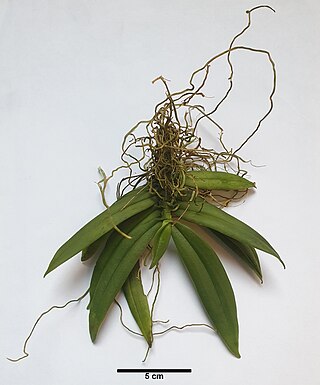
Grosourdya is a genus of flowering plants from the orchid family, Orchidaceae. As of May 2022, it contains 26 known species, native to Southeast Asia.
- Grosourdya appendiculata(Blume) Rchb.f. - widespread from Hainan to the Andaman Islands to the Philippines and Maluku
- Grosourdya bicornutaJ.J.Wood & A.L.Lamb - Sabah
- Grosourdya bigibba (Schltr.) Kocyan & Schuit.
- Grosourdya calliferaSeidenf. - Thailand
- Grosourdya ciliata (Ridl.) Kocyan & Schuit.
- Grosourdya decipiens (J.J.Sm.) Kocyan & Schuit.
- Grosourdya emarginata (Blume) Rchb.f.
- Grosourdya fasciculata (Carr) Kocyan & Schuit.
- Grosourdya incurvicalcar(J.J.Sm.) Garay - Java, Peninsular Malaysia, Sulawesi
- Grosourdya leytensis (Ames) Kocyan & Schuit.
- Grosourdya lobata Kocyan & Schuit.
- Grosourdya milneri P.O'Byrne, Gokusing & J.J.Wood
- Grosourdya mindanaensis (Ames) Kocyan & Schuit.
- Grosourdya minutiflora(Ridl.) Garay - Pahang
- Grosourdya minutissima P.T.Ong & P.O'Byrne
- Grosourdya multistrata P.O'Byrne, J.J.Verm. & S.M.L.Lee
- Grosourdya muscosa(Rolfe) Garay - Peninsular Malaysia, Thailand, Andaman Islands
- Grosourdya myosurus (Ridl.) Kocyan & Schuit.
- Grosourdya nitida (Seidenf.) Kocyan & Schuit.
- Grosourdya pulvinifera(Schltr.) Garay - Sabah, Sulawesi
- Grosourdya quinquelobata(Schltr.) Garay - Sulawesi
- Grosourdya reflexicalcarP.O'Byrne & J.J.Verm.
- Grosourdya tripercus(Ames) Garay - Leyte
- Grosourdya urunensisJ.J.Wood, C.L.Chan & A.L.Lamb - Sabah
- Grosourdya vietnamica (Aver.) Kumar & S.W.Gale
- Grosourdya zollingeri(Rchb.f.) Rchb.f. - Java, Maluku

Thelasis, commonly known as fly orchids, is a genus of flowering plants from the orchid family, Orchidaceae. Plants in this genus are usually epiphytes, sometimes lithophytes or rarely terrestrials. Some species have pseudobulbs with up to three leaves, whilst others have several leaves in two ranks. A large number of small, white or greenish yellow flowers are borne on a thin, arching flowering stem. There are about thirty species, distributed from tropical and subtropical Asia to the southwest Pacific.

Micropera, commonly known as dismal orchids or 小囊兰属 is a genus of about twenty species of flowering plants from the orchid family, Orchidaceae. Plants in this genus are large epiphytes with thick roots, long, fibrous stems, linear leaves and whitish or yellow, non-resupinate flowers. The sepals and petals are similar to each other and the labellum is shoe-shaped or sac-like and has three lobes. It is found from Tibet to tropical Asia and the western Pacific Ocean.

Octarrhena, commonly known as grub orchids, is a genus of flowering plants from the orchid family, Orchidaceae. Plants in this genus are small, orchids with short stems, thin roots, short, thick, fleshy leaves arranged in two ranks and tiny flowers. The labellum is rigidly attached to the base of the column. There are about fifty species native to areas from Sri Lanka and Malesia to the Western Pacific.

Pomatocalpa, commonly known as bladder orchids, or 鹿角兰属 , is a genus of about twenty five species from the orchid family, Orchidaceae. Plants in this genus are epiphytes or lithophytes with thick, leathery leaves and a large number of small flowers with a three-lobed labellum. There are about twenty five species found from tropical and subtropical Asia to the south-west Pacific.

Saccolabiopsis, commonly known as pitcher orchids, is a genus of flowering plants from the orchid family, Orchidaceae. Plants in this genus are small epiphytes with short, fibrous stems, smooth, thin roots, a few thin, oblong to lance-shaped leaves in two ranks and large numbers of small green flowers on an unbranched flowering stem. There are about fifteen species found from the eastern Himalayas to the south-west Pacific.
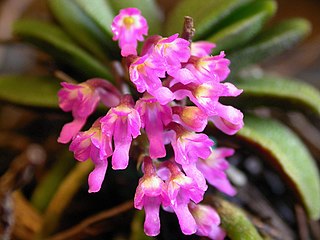
Schoenorchis, commonly known as flea orchids, or 匙唇兰属 in Chinese, is a genus of flowering plants from the orchid family, Orchidaceae. Plants in this genus are small epiphytes with thin roots, thin leafy stems with leaves in two ranks and tiny fragrant, almost tube-shaped flowers with a prominently spurred labellum. There are about twenty five species found from tropical and subtropical Asia to the Western Pacific.



















